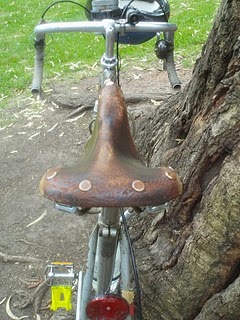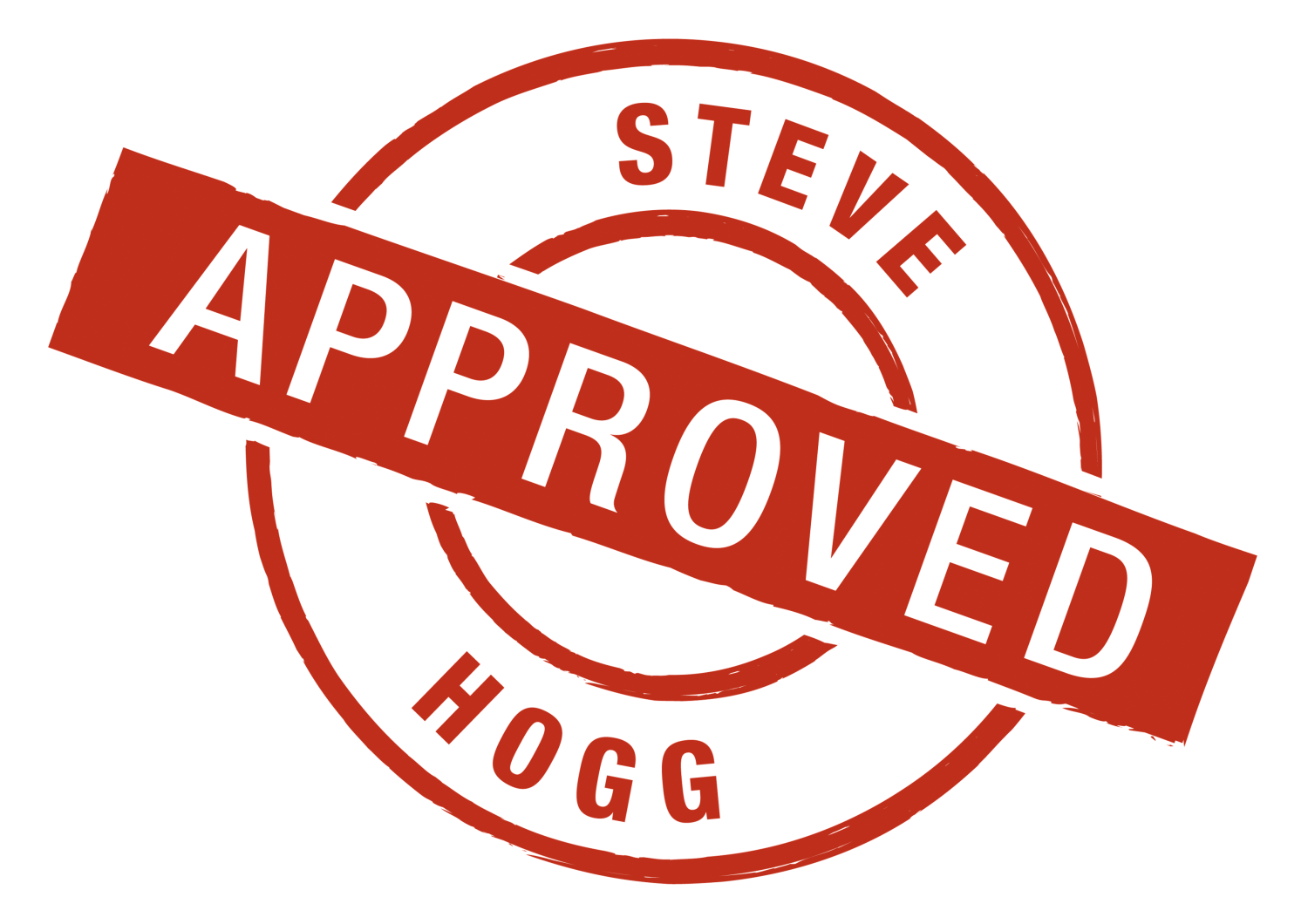Last Updated on March 26, 2013 by Steve Hogg
 Thank you to vegan superstar and endurance rider par excellence Harley Johnson, for this snap from his travels. What has this pic got to with pelvic asymmetry?
Thank you to vegan superstar and endurance rider par excellence Harley Johnson, for this snap from his travels. What has this pic got to with pelvic asymmetry?
Have a closer look how 30 years of sitting asymmetrically has distorted the seat. If this isn’t obvious, hold your Control key down with one finger and tap on the + key several times until the pic is large enough for you. It is a safe assumption that this rider sits further forward with his right ischium (sit bone) and rolls his right hip forward with each right side pedal down stroke. It also means that his ‘tackle’ hangs to the right when riding because there is no room on this seat with this mode of sitting for it to hang anywhere else!
Pelvic symmetry while riding is crucial because the effects of the lack of it flow outward to the periphery. What does that mean?
It means any or all of the following; that the plane of movement of each hip varies; the plane of movement of one or both knees is challenged; each leg reaches a different distance to the pedals; one side of the torso has to reach further forward than the other; one shoulder is thrust forward of the other shoulder; one elbow is closer to being locked than the other, each sit bone bears a different load and that the muscle enlistment pattern of each side varies.
Pelvic asymmetry when standing can be seen in something over 95% of the fitting clients I see year in, year out. It will be a lateral pelvic tilt where one posterior iliac crest will sit higher than the other (most commonly the left side is high) and / or one iliac crest will sit further forward than the other. Sometimes there is a concurrent measurable leg length difference but more commonly there is not.
My motto is that COMFORT+EFFICIENCY=PERFORMANCE. Pelvic asymmetries negatively impact each of these things. The more symmetrically we function, the better we interact with that positionally symmetrical machine that we all love, the bicycle.
Without going into the detail of why pelvic asymmetries occur, if they occur off the bike, they will occur on the bike. Here are some well known and less well known ways to resolve pelvic asymmetries when off the bike completely if there is no leg length difference OR moderate them markedly if there is a measurable leg length difference.
Stand and sit TALL. Good posture = improved lumbar spine support = improved proprioceptive clarity from the lower limbs and feet = restoration of pelvic symmetry
- A perfectly prescribed pair of orthoses will restore symmetry for the same reasons as above. Unfortunately, perfectly prescribed orthoses are not as common as they should be.
- Close one eye. More commonly it is closing or covering the right eye that will restore pelvic symmetry. Less commonly it is the left eye that needs to be covered. Approximately 50% of our optic fibres play a part in balance, coordination and spatial awareness. If this type of information is not processed properly, then our awareness of what ‘upright’ is is skewed and our posture changes to accommodate that skewed awareness. Blocking visual feedback from the appropriate eye, or better still, retraining the visual cortex in how to process spatial information from that eye solves the problem. This is VERY common with my records showing a 3 year average of 88% of my fit clients. The only thing that is uncommon is next to no one seems to be aware of it!
- Wear MBT or Skechers brand of footware. These brands have rocker shaped soles that introduce a measure of instability to our gait and stance. Paradoxically, this seems to cause stabilising muscles of the lower limbs to switch on and posture improves with the improved proprioceptive clarity that results solving the problem.
- Wearing the appropriate choice of one of 4 colour frequencies of non prescription lenses over the affected eye resolves the problem. Sorry; to find out which colour suits you, a fit booking will be essential.
- Re train the cerebellum so as to reduce or eliminate any tendency to hemispheric motor control dominance. In my experience, Feldenkrais technique is the most effective self help method in achieving this.
No one sits perfectly squarely on a bike. The level of asymmetry varies from near imperceptible to very obvious. I don’t have the space or time to cover the many measures and combinations of measures that can be applied to improve pelvic symmetry during a bike fit. I hope I’ve got you thinking though.
Note: Often, more specific answers to your questions can be found in the Comments below or in the eBooks section and FAQ page.
To learn more about bike fit products offered by Steve, click here.
Do you have a bike fit success story? Please go here to share.
Thank you for reading, return to the Blog page here or please comment below.Comments (12)
Comments are closed.







Steve
Great blog!! I write this question because I think pelvic antisymmetry is causing me a problem. Besides working on my body(which I am doing) what can I do about it on the bike. If I scoot myself to the right mindfully everything works but it is hard to ride like that. Here is my reasoning. I have a persistent problem with my right foot never feeling solid on the pedal and always feeling like I was reaching. The reaching went away if I shimmed it but still was not stable. My left with 1 wedge feels stable and controlled at heights varying up to 15 mm of saddle height. I have been through the wedges and shimming stages and it never would feel correct on right side. I had some one video me from behind and I sit to the left side and my right glute rises off the saddle. More when I am higher but still some when low. Much to my shock when I measured my ant iliac crests I am not symmetric. Left side is higher and slightly posterior. When I scoot to the middle or slightly to the right all of a sudden with two wedges in I fell solid on the right and even with no shim no longer reaching. My body though dose not want to stay there on the seat.
Thanks
Bill
fyi- When all feels correct I am sitting 12mm lower than my previous fits.
G’day Bill,
What happens if you persist in riding “12 mm lower than my
previous fits”?
Say for a month?
I ask because I see many, many people who have been previously fitted who
are sitting too high. The post SEAT HEIGHT – HOW HARD CAN IT BE? explains
more.
Hi Steve,
First off, thank you for your fantastic insights and sharing your knowledge. I’m a bike fitter in the San Diego area, and have long followed your advice in the the CyclingNews Fitness Q&A. Your your expertise has lead to newfound comfort for many of my clients. I just discovered this blog, and once again, have learned a ton of new techniques and ideas that I will incorporate into my practice.
Here’s my question related to pelvic rotation: Do you know if the FSA K Force seatpost with the datahead is still available? I ordered one, but it didn’t have the same design you’d referenced in the past. I’ve been working with a client for months, and all attempts to solve his discomfort due to his pelvic rotation just haven’t worked. This is one situation where I must move the saddle laterally to provide support for his right sit bone. In fact, his saddle is deformed to the same degree as the one pictured in your article. Any idea where I can find a seatpost that will allow for side to side movement, yet keep saddle’s nose in line with the bike’s centerline?
Eric Bowen
VeloFit Revolution
http://www.velofitter.com
San Marcos, CA
G’day Eric,
Thank you for your positive thoughts. FSA don’t make the the
Data Head any more which is a pity for the small minority of people who need
a laterally offset seat. I sympathise and still have a few. I’m happy to
point one in your direction. They will fit existing FSA K Force and Thomson
seat posts. Contact me privately via pedalpushers@bigpond.com
G’day Steve and all the other readers,
first off all, I don´t know where to write about my experience I´d like to share. It´s related to pelvic asymmetry so I will post here. Perhaps you remember me, Steve. I´m the german physio/osteopath who also works in a bikeshop. One of the first clients I worked with (as a bikefitter) was my wife. It was very hard, because she had multiple issues on the road and mountainbike. But we solved all her problems.
Some time passed. She felt very comfortable, stable and had a large increase in speed, stamina and so on. Then we decided to make a chance in contraception. My wife changed from oral hormone contraceptives to an intrauterine device. The first thing we noticed was a radical chance in her pelvic asymmetry. Her functional leg length nearly vanished. We had to change the whole bike setup. That was very interesting. We knew, that artificil hormones can be a bad thing. I know, that they change the postural situation, but it was an eye opener.
Have recognized something like this too?
Sorry for my english, I´m from Germany.
Greetings, Florian!
G’day Florian,
I remember you well and your English is fine. Far better
than my Deutsch. Re contraceptives, I have seen what you mention but only a
few times. What I mean by that is that only a few times have I see women who
were taking oral contraceptives and then at a later date were not taking
oral contraceptives. In some of these cases (not all by any means) there was
a radical improvement in pelvic symmetry. I had often wondered whether oral
contraceptives played a part in what I observed but had no way of being
certain. So your wife’s experience is a welcome addition and I thank you
very much for passing it on.
The same thing can (not will) occur if someone has coeliac disease, a dairy
intolerance or any other common food allergies. I think the matter we all
need to be aware of is that every system, every structure and every process
of the body are interrelated. Everything affects everything else, though
there is such wide individual variance that often matters like this can be
hard to predict in advance.
Good to hear from you Florian and thanks again for the information. Very
interesting.
Hi Steve
Really liked this article, made me realise I’m not alone in feeling wonky on my bike.
I haven’t had my bike fitted to me (ever) and I’m fairly sure I have pelvic asymmetry. Sometimes when I pedal I can feel the nose of my saddle rubbing against my right inner leg, and I only ever get saddle sores on the right hand side of… that place. Furthermore, when I put my aerobars on my old steel TT bike with a very small reach, only my left leg seems to hit the left elbow pad, my right seems to easily miss. Finally I often discover that I have accidentally been riding with my right arm locked and my left elbow slightly bent, and it feels totally natural! With the methods that you suggest to ‘cure’ pelvic asymmetry, how long does it take for these to take effect? Would it suffice to just chose one method (sitting up straight say, I tend to slouch) or is doing all of them necessary?
I do race very often, and I plan on getting quite serious about it, maybe competing on an elite level one day (I’m only young!) so I’d rather kill this problem quickly and permanently, before it grows and I can no longer do very long rider (I fear I may be near that stage as it is)
Regards
Luke
G’day Luke,
Everything you say suggests that you are twisting forward,
probably on the left but there is a possibility that it is to the right.
You’re a young guy so it is important that you get off on the right track
early. Here’s what I suggest.
1. Firstly, get hold of “Flexibility for Cyclists’ by Fred and Kelly
McDaniel available from http://www.humanperformancecenter.com. It is a cheap,
accessible and well laid out stretching program for anyone who rides a bike
or who sits down a lot (all of us). Make stretching your second religion; it
is that important. If you can get to a formal yoga or similar class, even
better, but get the book as you will need to do something at home anyway.
2. Next, read the posts on seat height and set your seat height by the
method described in Seat Height – How Hard Can It Be. Time and again, a
major component of an asymmetric way of sitting is too high a seat height.
Not always, just a lot.
3. The methods I mentioned in the post will work off the bike; not
necessarily on the bike. Each case is different. The whole point of that
post was to highlight the issue and start a discussion. I’m not sure that
side of things has been successful.
4. Strip to the waist and stand in front of the bathroom mirror. Make sure
that both knees are locked out (straightened as much as possible). Move your
thumbs down your sides until they contact the top of your pelvis. Are they
at the same height?
If yes, good. If no, as I suspect, have a helper kneel behind you with
fingers on top of pelvis (iliac crests) on either side while you still stand
with knees locked and reach for the ceiling as hard as you can with your
arms. Stretch right out. Are both sides of your pelvis the same height while
standing like that?
If yes, good, you have a functional issue that can be sorted out with
stretching (and the methods in the post that you have mentioned). If no, not
so good. if so…………
5. Repeat the reaching for the ceiling forcefully exercise with your helper
locating the top of your pelvis on either side, but this time while sitting
in a hard chair. Are your iliac crest heights level now?
I expect the answer to be yes, which means a no in 4 means that there is a
possible leg length difference. This is not certain, but likely.
If the answer to 5 is no, then you may be one of the tiny percentage who has
what is called a small hemipelvis. If this is the case, get back to me.
6. Eliminate all dairy products from your diet. No cows milk, cheeses or
yogurt. This is a shotgun approach as I don’t know that you have a
sensitivity to dairy products. The funny thing is that I see a LOT of people
who do, usually unknowingly. Any food allergen, if consumed, has a negative
impact on pelvic symmetry. When you do this, give it 6- 8 weeks before
making a judgement. If this is the problem or part of the problem, it
usually takes about 6 weeks to feel any positive effects of the dairy free
diet.
There is a few things to work on. Best of luck.
So i’ve got some issues..20 years old.
My right leg is longer by a little over half an inch, both in femur and tibia, mostly femur. I use a 1/2 inch heel lift when walking and whatnot. Also believe i have small hemipelvis as my pelvis is never level when i sit and sometimes need a lift under the left (short side) or else i will get major discomfort. Pretty sure the right side of my body is just slightly larger, even my forearm bone is longer on right.
Should i get one side of the seat up as well as adjust one pedal?
Lately i’ve been considering having a leg lengthening operation on the short leg, because having a lift in every shoe and not being comfortable barefoot really bothers me, along with being limited in my physical activities.
Tough decision at my age.. definately causes me back pain and stuff. Been to many docs and thats the only thing besides a lift that will fix the imbalance in long term.
G’day Rushed,
The first thing you need to do is establish with certainty whether you have a small hemipelvis. An X ray or scan will do this. Let’s assume that you have. If the relative difference in ischio pubic ramen is known, then the seat of the smaller side can be built up. You will need a motor trimmer to do the job well. If you are in Australia I can point you at the right guy because he has done similar work for us and others.
The leg length difference is relatively easy to solve on a bike via shims, or if really necessary, a built up sole on the cycling shoe. Any competent bootmaker should be able to do this. Again, if you live in Oz, let me know and I’ll point you are the right person to do the job.
I’d be wary of the leg lengthening operation. Basically your leg is broken and then put in traction to stop the two ends of the bone knitting so that they have to grow towards each other. Typically it is the femur that is broken. What can happen though, is that the ‘fix’ causes ongoing hamstring problems because while the femur can be lengthened by 1/2 an inch fairly easily, muscles don’t lengthen quite so easily. The other thing is that you
say that the disparity is in both femur and tibial/fibula. Lengthening the femur will give you two legs the same length in standing posture but with different proportions between legs (and probable hamstring problems on the lengthened side)
You are young and I’ve seen people with far greater asymmetries than yours live a pain free and active life because:
1. They made the development of exceptional core strength a major priority in their lives. Have a look at this link *www.ndu.edu/HealthFitness/docUploaded/Physioballs.pdf*
download the manual and get started. It would also be a good idea to get hold of a copy of “Overcome Neck and Back Pain” by Kit Laughlin as it covers the type of issues you have. We sell it but it is readily available elsewhere as well.
2. Don’t think your life is over. Luc Leblanc was World Road Champion, won stages of the Tour and the Tour K.O.M. title with a right leg that was 3cm shorter than his left. This was the result of being hit by a car as a child. He wore a built up walking and cycling shoe and was a serious competitor.
3. Once you are on top of the core exercises, stretch regularly.
Best of luck.
Steve, thank you for your response. Reading through some of your related posts, i would say i fall into category 3: none of the physicians i have seen seem to give a crap or really follow through.
The reason i want the op done is because i get significant back pain, especially running. Also do weightlifting and unevenness is present and bothersome. The idea of getting every pair of shoes modified and never being able to be barefoot is really daunting, as well as always having to have shoes on in order to be level. I used to always run around barefoot as a kid and this really bothers me.
Here’s a couple pics from last year with the psis marked. you can see a marked asymmetry.
http://imageshack.us/photo/my-images/196/img0967kk.jpg/
http://imageshack.us/photo/my-images/29/img0968go.jpg/
I’ve had imaging studies of all sorts and the doctors always look for fractures/damage and don’t seem to know how to screen for the small hemipelvis. To be honest i have all the studies on discs and think they just need proper evaluations. X-rays, MRI, you name it.. I always get the “oh, thats not common so it must not be the case” spiel. Have consulted with leg lengthening place for the discrepancy and am borderline operable. I feel like my quality of like will improve significantly, but i’m somewhat afraid to go through with it. However, the sooner I do it, the sooner I can get my life back together and the less damage my joints will sustain from uneven forces.
I’m also worried if I don’t go through with it now, it will be harder to deal with as I age.
I’m not overly concerned about the muscle issues resulting from the procedure as the amount of lengthening is under an inch, and many people have undergone much, much more lengthening without complications.
I’m actually from Austin Texas, and plan to get an appointment with Jerry Gerlich for a fitting this coming week, as he sounds very knowledgeable on such subjects judging by a few of his posts.
I understand. Yes, see Jerry. He is knowledgeable, but what is better, is
that he takes a common sense approach to most things.